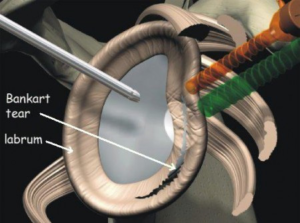What is a Bankart and Reverse Bankart Tear?
Reverse Bankart and Plication Repair
Surgery performed by Dr. Chams
Your labrum is anatomically divided into several compartments including anterior (bankart) and posterior (reverse bankart).
Bankart Lesions
Bankart lesions occur to the anterior portion of the labrum. Picture the labrum as a clock, bankart lesions are from the 2 o’clock to 6 o’clock position. This results when the head of the upper arm bone (humerus) translates anterior (forward) out or off the socket (glenoid) causing the fibrous tissue (labrum) to tear. Occasional a forceful subluxation or dislocation can cause on osseous bankart. This is a tear of the anterior labrum and fracture of the glenoid. Symptoms can include pain throughout the shoulder, feelings of instability, popping and grinding. With this type of injury activities, overhead such as throwing a ball or reaching to your side can be problematic.

Reverse Bankart
Reverse bankart lesions occur to the posterior portion of the labrum. Picture the labrum as a clock, reverse bankart lesions are from the 6 o’clock to 11 o’clock position. This results when the head of the upper arm bone (humerus) translates posterior (backward) out or off the socket (glenoid) causing the fibrous tissue (labrum) to tear. Symptoms can include pain throughout the shoulder, feelings of instability, popping and grinding. This type of injury can occur with activities such as performing a bench press, stiff arm blocking in football and lacrosse or a motor vehicle accident while holding onto the steering wheel. Symptoms can range from decreased range of motion, pain, and instability, catching, popping and grinding. These symptoms usually occur with activities overhead or away from your chest.
Diagnosis
Diagnosis can be determined by a thorough history and physical examination by a trained sports medicine and orthopedic shoulder specialist. Once the initial diagnosis has been made through special anatomical testing, an MRI arthrogram (3 dimensional picture with contrast injection) may be ordered to confirm the diagnosis and assist in determining the severity of the tissue injury. Occasionally, X-rays of the shoulder complex will be ordered to determine if any bony conditions exist prior to your MRI arthrogram.
Treatments
Treatments can include conservative versus surgical management. A specific individualized treatment program will be created from your thorough history, physical examination, and radiological testing. Conservative management can consist of anti-inflammatory medications, a cortisone injection, orthobiologics, physical therapy and/or rest. Surgical management may be recommend pending the severity of the damage to the labrum. Labral tears are surgically repaired though arthroscopic visualization.
Shoulder Arthroscopy
Shoulder arthroscopy occurs when a small camera is placed into the shoulder joint to visualize the labral damage. During this visualization, ligaments, bones, and muscles of the shoulder complex is further assessed by the orthopedic surgeon. Once the assessment has been completed the surgeon uses a variety of instrumentation to repair the fibrous complex and ligaments to re-stabilize the shoulder.
Rehabilitation
Rehabilitation post-operatively will begin immediately. Patients will be placed into a sling for 4-6 weeks. A home exercise program will begin immediately following surgery. These exercises will be performed until formal rehabilitation can begin one to two weeks post-surgical repair pending its severity. Patients may shower the next day following surgery and may operate a vehicle once off narcotic medications. Patients can return to school or desk work as soon as one feels comfortable which is usually within the first-week post procedure. A physical therapist or athletic trainer will begin your formal rehabilitation through a planned rehabilitation protocol. Initial outpatient sessions will consist of obtaining pain-free passive range of motion. Strengthening of the shoulder complex will begin around the 8-10 week post-operative phase once range of motion has been achieved. Total recovery from labral repair can range from 4-8 months depending on the extent of the tear and what sport the individual is returning too.
